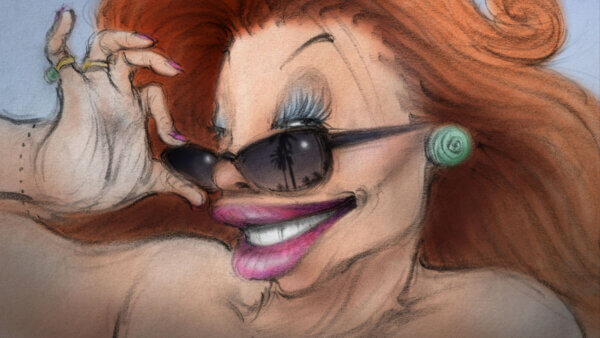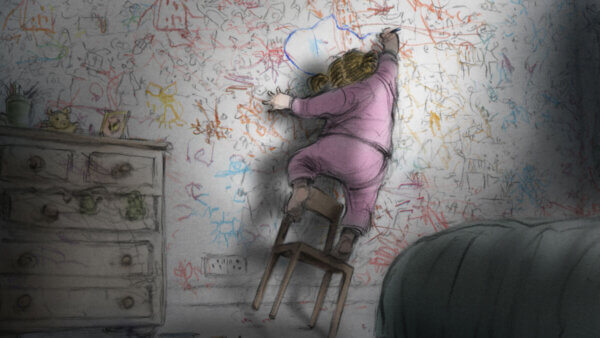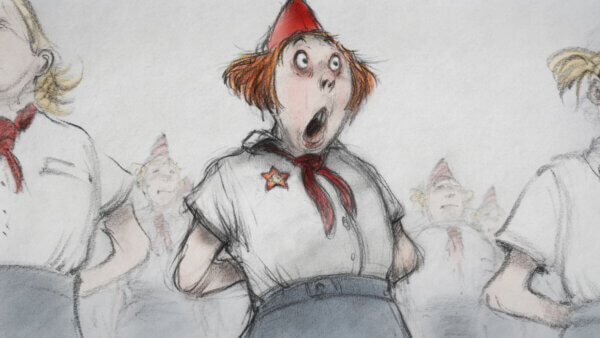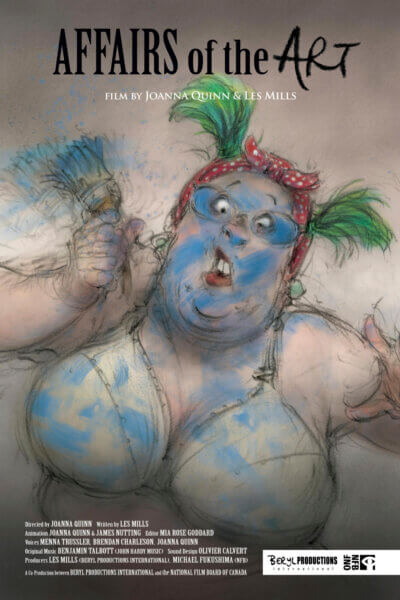Affairs of the Art – Interview with Joanna Quinn and Les Mills Part 2
The adventures of Welsh housewife Beryl, first made famous in the short film Girl’s Night Out are adored internationally. With a brand new film hitting the festival circuit we caught up with Director Joanna Quinn and Writer Les Mills to further discuss the journey the pair have been on in producing the hilarious, hand-drawn tale of obsession, family and pickling!

Photo : © NFB and Beryl Productions International
Produced with the National Film Board of Canada, the film is screening until the 6th February at Clermont-Ferrand International Short Film Festival so French viewers don’t have long left to catch the premiere of the latest film from Beryl Productions.
In part two of our extensive interview, we discuss the importance of art school, hand drawn versus digital animation, working with the NFB on a very Welsh story and if this is indeed the final outing for Beryl.
Over the years we have seen the evolution of Beryl as a character, in this film we continue seeing her love for the arts and her love for drawing, there are moments where it seems almost autobiographical for you both.
LM: Some of the images of Beryl as a kid are basically Joanna
JQ: Yes, in the film there’s a scene of little Beryl as a kid drawing over the walls (hippy parents, they let me!) my bedroom was completely covered in drawings – also in the film (spoiler alert!) Beryl is caught drawing her teacher in the nude, that was me too! It was slightly different though as I drew my character in the bath nude. So it’s autobiographical.
LM: We changed the name of the character in the film!

Photo : © NFB and Beryl Productions International
JQ: After so many years of doing adverts I was desperate to do my own art so I think the film is slightly autobiographical, even though I spent years drawing and creating and doing lovely drawings it was always for someone else or selling someone else’s product – someone else’s vision, and you end up being a service industry really because you can make as many suggestions as you want but ultimately it’s someone else’s idea and you’re doing that as best as you can, so I was a little bit desperate to make another film and make it about art. We both absolutely love art, I love drawing, I’d be happy to draw all day and just draw, draw, draw. That’s my background, just being quite solitary and drawing so animation is perfect. Les is from a fine art background so he is an artist.
LM: I moved from fine art to filmmaking using super 8 film and I got obsessed with the immediacy of making films. When I came back to the UK I taught in a technical college in London which had a TV studio so they were being taught the technical side of things but nobody was teaching the students how to be creative, so I got involved in that. I was teaching motor mechanic students one day and got them to make an advert, and they did, the did stop frame animation and all sorts of things and I didn’t know anything about it, I was just telling them to do it. Meanwhile down the road Joanna was doing her degree in animation and feeding me stuff back, showing me how to do animation which I’d pass onto the students. I then went on to teach basic animation at Middlesex.
So writing a film about an artist comes as second nature?
LM: Absolutely! The best thing I ever did in my life was go to art college, first day you arrive they stick you in a room with a drawing board and a piece of paper and a naked woman walks in and you have to draw her! Everyone sits around silently drawing and you think to yourself ‘what is this!’ the experience of art college is amazing, if you don’t do anything creative in your life then you don’t have that experience of doing something of your own and expressing yourself and that’s the greatest thing in life and the more people do it the better.
The film takes us everywhere, Wales (Look out for the cameo from Newport Art school), Hollywood, Moscow and everywhere else, in your research did you go to Moscow?
JQ: Yes, we went to an animation festival with the last film and got to look around Moscow (it was a dream to go there!) and we visited Lenin’s tomb. We had already thought we would quite like to have Lenin in the film so we went in to audition him! I had my sketchbook and we queued up to see him and got told off.
LM: Before you go in you have to leave your cameras with the guards, but we asked if we could draw him. The guard agreed but Joanna had to keep moving in the queue around him! So she was animating herself and Lenin as she walked around! I don’t know if we’d written the scene before going to see Lenin?
JQ: He was so handsome!
There’s a moment in the film which seems to be a tongue in cheek nod to The Snowman based on Beverly’s obsession with Lenin. It’s a very funny vision, was this on purpose?
JQ: It wasn’t really on purpose, the idea was that Lenin and Beverly would fly off into GUM (Russian Department store) and have Pirozhki but I chopped the Pirozhki bit out because I couldn’t do anymore drawing, so we made more of the flight, so the flight had more importance than we had anticipated, so when we looked back on it we thought it looked a bit like The Snowman with Lenin.

Photo : © NFB and Beryl Productions International
LM: It still fits, Beverly was obsessed with Lenin and preservation and so she joins the young communists in Wales because every year they go to see Lenin’s tomb. In addition Beverly dreams these sequences. It’s a bit tongue in cheek.
Since Dreams and Desires: Family Ties, you experimented with digital paper, let us know how did you find the right technique for Affairs of the Art?
JQ: I bought a Cintiq, what I wanted to do was make a film that looked hand drawn but was actually digital because I wanted to be modern, but experiment and stretch it so it had the organic feel of pencil on paper. So I animated using TV Paint for about six months, as there was no great pressure with the deadline I was able to play around and learn the software which I really enjoyed, but I just found the process of animating digitally is very different to animating on paper and one of the big differences is that you can see your animation as you go along.
So as I was animating I was flicking back and in some cases you could see the whole sequence as you go along. I just found it a very different way of animating because at no point you would stop and assess what you animated with a fresh pair of eyes and say ‘actually that bit’s not working’, because when you’re animating on paper you animate before testing and when you test you see it moving for the first time, see what works and what doesn’t work, so that’s what I was missing. Also , the physical act of drawing wasn’t as pleasurable on a Cintiq as it was on paper. I didn’t realise how much I would miss the act of drawing and the way you can play with a line, you can do anything with a pencil and it’s instant, from the brain through the pencil and onto the paper – it’s easy. When you work digitally you have to plan what you’re doing because you have to press buttons in order to do what you’re going to do so it’s less intuitive. Having said that different people who we worked with in the studio, who are all super young, who have been brought up with digital animation, who found it intuitive because they had been brought up digital, so it’s all swings and roundabouts really.
JQ: So I decided to go back to paper for two reasons, one because Les could see I wasn’t enjoying it and said why I didn’t just get my Lightbox out and draw on paper again, which I felt was like going back in time and also I got a letter from Regina Pessoa who had heard that I was working digitally and she wrote to me and said “NO! DON’T You have to stay on paper, you MUST!” and so I went back to paper and so I was happy again!
LM: Not only are all the thing she said about the movement and the act of drawing true, but also the quality of a pencil and the line is textural and you can alter it by instinct, but to try and do it digitally is a huge step and Joanna could not get the quality correct
JQ: I worked really closely with the team at TV Paint and we made designed lots of different brushes, but we just couldn’t get it right and I spent so long trying to make it look like a pencil in the end I just thought ‘sod it I’ll just use a pencil’ ha ha ha!
The NFB helped bring the new film to the screen, how was it working with the NFB on a very Welsh story!
LM: They knew the character of Beryl very well. We had planned on doing most of the film over here and doing the post production in Canada, but Covid prevented us from going over to do that which is unfortunate. We found our own sound designers in the end who were brilliant actually considering everyone had to work with masks on with screens between us and taking temperatures before we went into the room!

Photo : © NFB and Beryl Productions International
JQ: We very nearly bought the tickets, but in the end we didn’t, but it’s fantastic being able to work with the NFB because they are the NFB! What a fantastic reputation they have.
LM: If only we had one here!
JQ: They’re a bit like the BFI and the BBC rolled into one.
Releasing the film during a pandemic means that the film is more accessible but at the same time you and the audience are missing out on the festival experience. What are your thoughts and feelings on being a filmmaker at this time?
JQ: It’s pretty devastating I must say after working on the film for so long because making an animated film is such a long laborious project that the big carrot dangling at the end of the stick is going to film festivals at the end, which is what kept me going so not being able to go is really sad.
LM: It’s a disaster really, because not only getting your film seen and getting interesting feedback, but also meeting up with other filmmakers and mingling and catching up, it’s the most amazing thing ever, being able to see all the other amazing films too.
JQ: The delight of going to a film festival is going into a cinema, the lights go down and you don’t know what you’re going to watch and you don’t budge and you watch all the films, you get up and you’ve watched all these films you might never have watched and you’re surrounded by the people who made them. It’s a lovely surprising educational experience going to a film festival. We’ve been doing a lot of online festivals, which I thought wouldn’t’ be as good but some things are much better. I think that being able to watch things at your own time is really nice, seeing all the talks and panel discussions have been the best thing and those things you can do online you couldn’t have done unless you went so it enables a whole load of people to experience those festival treats without leaving their living room. I think what doesn’t work as well is the experience of actually watching the films because when you’re at a festival you take the week off and dedicate yourself to it, and I know I have been attending these events at the same time of working.
LM: There’s something incredibly special about being in a darkening auditorium. We just spend ages working out the sound and we’re only going to be watching it on a tiny screen! It’s not the same as being in a room with a thousand people.
JQ: It’s admirable how festivals have managed to switch from in-person to online and all really successfully, all the ones I’ve visited online have had different things that have been strong.
We learn more about Beryl in this film than any other Beryl film, will there be any more Beryl films?
JQ: No there won’t! I want to make another film, it’s going to be 30 seconds long, hand drawn, no backgrounds and just animation flying around.
LM: She just wants to do Britannia again but put a cat in it or something! We thought at one point we might do five or so retrospectives of different countries using their national emblems, these are all ideas. There’s a lot of feeling in Britannia and it’s very meaningful, not only because the animation is great but also it’s part of our own heritage and history and you wonder if people in other countries realise they are colonialists, they all did it.
Britannia has a great message which is often rediscovered on social media, it must be gratifying to create films that people still watch to this day.
JQ: That’s the really exciting part!
LM: Yes, the tendency is that films sometimes disappear and it’s only when the filmmakers have a retrospective that they appear again. You have to make something enduring and powerful, not just something that’s immediate.
JQ: But also use humour to pull people in!
The new Beryl Film Affairs of the Art is screening now at Clermont-Ferrand International Short Film Festival until the 6th February 2021. Catch part one of our interview with Joanna Quinn and Les Mills here.


